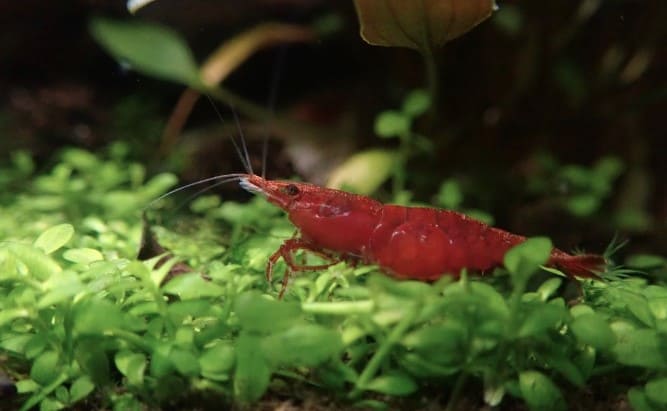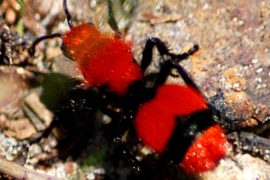If you want to set up a new aquarium for shrimp, you should read here. With a little know-how, it is very easy to offer the popular invertebrates an optimal habitat in the aquarium. In this small guide, we summarize what is important when choosing plants, furnishings, and the like.
The optimal substrate for shrimp in the aquarium
The substrate in the shrimp tank should ideally consist of medium-grain gravel for most shrimp species. The animals are constantly looking for food on the ground. In doing so, they diligently turn grain by grain. If the gravel is coarse, the food falls down through the cracks between the stones and is no longer accessible to the shrimp.
The dark substrate is the right choice for many colorful shrimp species. In nature, the animals camouflage themselves on a dark background by expanding the pigment cells in their armor and thus appearing darker. Enter light ground, and pull the color cells together again. The colors of the shrimp shine much more brightly on a dark substrate in the aquarium.
Tip: Don’t be too meticulous about cleaning shrimp in the aquarium. There may well be a small corner with Mulm. The shrimp find plenty of food there. But keep an eye on the water values and don’t be careless with the care of the aquarium.
Roots for the shrimp aquarium
Roots are a popular piece of furniture in the shrimp aquarium. They are ideal for structuring the tank and providing the shrimp with natural habitat. However, keep in mind that the water values can change as a result of the roots in the aquarium. Many shrimp lovers swear by the positive effects of the tannins that the roots release into the water. Before purchasing, find out which roots are suitable for the shrimp aquarium and, if in doubt, seek advice from your specialist retailer.
You should also set up an aquarium for rooted shrimp because the animals love to be there. Because the wood slowly decomposes in water, it provides excellent grazing ground. The wood particles that the shrimp ingest while eating are considered healthy supplementary food. Last but not least, roots offer the possibility of tying up epiphytic plants or mosses to make the shrimp tank particularly varied.
Attention: Only aquarium roots that have not been chemically treated belong in the shrimp aquarium. During storage, some roots are treated with pesticides to protect them, which are lethal for shrimp. You can obtain suitable roots from your trusted specialist retailer.
Stones in the shrimp aquarium
Shrimp love to hide in burrows. Offer you plenty of them. Wonderful hiding places can be built from stones fixed with aquarium silicone. Slate stairs also look great in the shrimp tank. When selecting the stones, also consider the possible effects on the water parameters. The following applies to shrimp in the aquarium: do not use calcareous stones. They harden the water and shrimp prefer a low water hardness.
Tip: To test whether a stone contains limescale, drop some vinegar essence on it. If foam forms, lime is present in the rock.
Set up a shrimp aquarium: choose suitable plants
Lush planting in the shrimp aquarium is a must. It forms a hiding place and source of food in one. A fine growth of microorganisms, algae, and other delicacies for the invertebrates forms on the plants.
Fine-leaved plants belong in every shrimp tank. Because a lot of suspended matter gets caught in the fine leaves, shrimp-like look for food here. Youngsters in particular like to stay in the fine thicket. Ground cover should also be planned for in the shrimp aquarium when setting it up. They provide shelter and an excellent source of food from the mulm that forms beneath them. Mosses should not be missing in any shrimp aquarium: as greenery for the mat filter, attached to roots or stones, or as a cushion on the substrate, they will quickly become your protégés’ favorite place.
Tip: When keeping shrimp in the aquarium, do not be too sparing with moss. Aquarium moss will double in volume within three to four weeks. If you only have a chestnut-sized amount of moss at the beginning, it will take you quite a while until a nice cushion has formed. If you start with a handful of moss, you can easily green up an entire rear wall of the pool in a short time. Ask your aquarium plant dealer about offers for larger quantities of moss for the shrimp aquarium, such as this Java moss in a portion can.
Setting up a shrimp aquarium: Which filter is the right one?
When choosing the filter for the shrimp aquarium, you should consider the following criteria:
- The filter performance and flow must match the needs of the animals.
- The filter must be closed or secured so that shrimp cannot enter.
Most shrimp species do not make any special demands on the current in the aquarium. A filter like the one found in a normal community tank will do just fine. An exception is the fan shrimp, which take their food from the running water. The other dwarf shrimp species feel comfortable with medium to low currents.
When keeping shrimp in the aquarium, the filter should be chosen very carefully in terms of safety for shrimp: they are very resourceful when looking for food, and the filter is an enticing source of food. In many filter models, the offspring of shrimp in particular easily fit through the openings in the suction area – with fatal consequences. Depending on the design, the shrimp can also reach the outlet. With astonishing exertion, they overcome the flow and get inside the filter. Shrimp-proof your filter with a fine mesh or lady’s stocking.
Tip: You often hear that the cables from the filter have to be secured against climbing shrimp so that they do not escape from the tank. However, shrimp only climb out of the water if it becomes difficult for them to survive there – if the water parameters are too bad or the temperature gets too high in summer, for example. If the shrimp in the aquarium attempt to escape, this is an alarm signal that something is very wrong in the aquarium.
Which filter for the shrimp aquarium? All criteria at a glance
If you are setting up an aquarium for shrimp and want to buy a new filter, it is best to use a sponge filter or a hamburger mat filter. The latter is not only harmless for the shrimp but also offers an excellent feeding place with its large surface.
Keeping shrimp in the aquarium
Once the aquarium has been prepared, the residents can move in. Versatile and sociable, these invertebrates have become extremely popular with aquarists, and some species are easy to keep. But shrimp are not only beautiful to look at in the aquarium, but they also fulfill a practical function: they help to care for the tank. They love fresh algae and simply pick them up out of the water with their hairy fans on their claws. Keeping shrimp in the aquarium is ideal, at least from a visual point of view.
In addition, shrimp are not only easy to keep and care for in the aquarium specially designed for them, they also prove themselves in the community with other residents. When choosing them, however, care should be taken to ensure that they correspond to the temperament of the shrimp: They should therefore neither be very large nor too hectic. The invertebrates also feel particularly comfortable when they have several conspecifics around them, so at least five to six animals should be kept together.
Frequently asked questions about aquarium plants for shrimp
Do shrimp eat aquarium plants?
Some shrimp keepers have found that the shrimp in the aquarium damage fine-feathered plants or mosses by tirelessly wiping with their brush hands. Amano shrimp in particular can be a bit rough when dealing with aquarium plants. Attacked or diseased parts are sometimes even eaten. Therefore, plant generously in the tank, do not put too many shrimp in, and try out the habits of your shrimp population. Normally, shrimps in the aquarium do not pose a threat to the plant population. However, if hundreds of “Amanos” pounce on a handful of java moss, then after two days only the leafless branches will remain.
Shrimp and Anubias: Can it be dangerous?
You hear again and again that Anubias are harmful to shrimp in the aquarium. However, many shrimp keepers have no problem cultivating plants of the genus Anubia (trade name: dwarf spear leaf) in the shrimp tank. It is now believed that this is not a problem as long as the plant does not sustain any major injuries. This is the case, for example, when she is circumcised.
Shrimp-safe plants for the aquarium
Are you one of those shrimp keepers who worry about adding new commercially available aquarium plants to your tank? You are not alone: you hear again and again that shrimp die after buying aquarium plants. This phenomenon is caused by pesticide residues that may be temporarily present on certain Asian trade crops. Only those who know what to look out for can successfully avoid this danger when buying aquarium plants for the shrimp tank.
The issue is particularly acute when inserting aquarium plants into a running tank. After setting up a new shrimp aquarium, on the other hand, it normally “runs in” for several weeks without stocking. Do this, making the appropriate partial water changes, should the plants have excreted any debris.
Do you have any questions or suggestions on the subject of “Setting up a shrimp aquarium”? We appreciate your comments!





